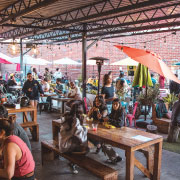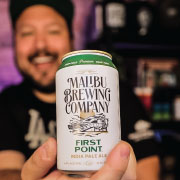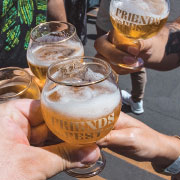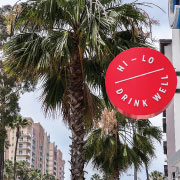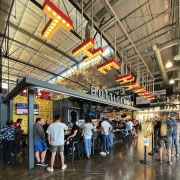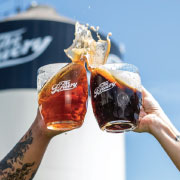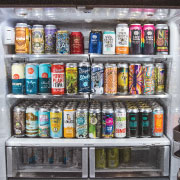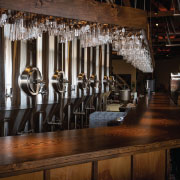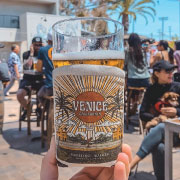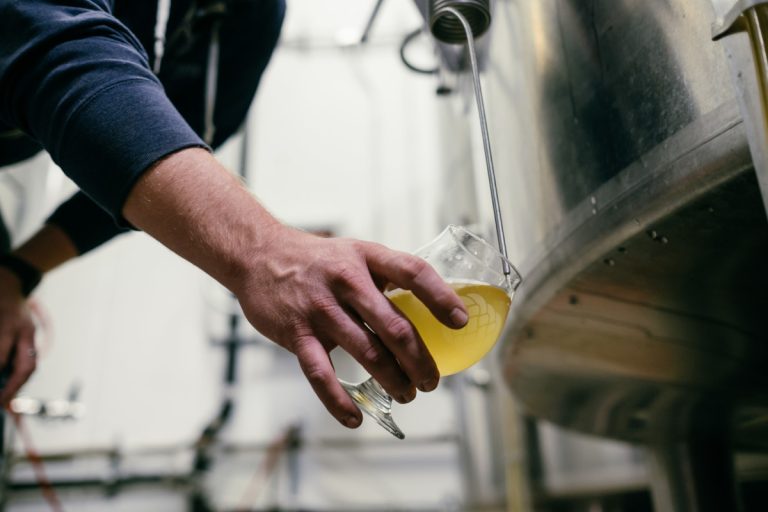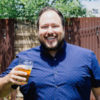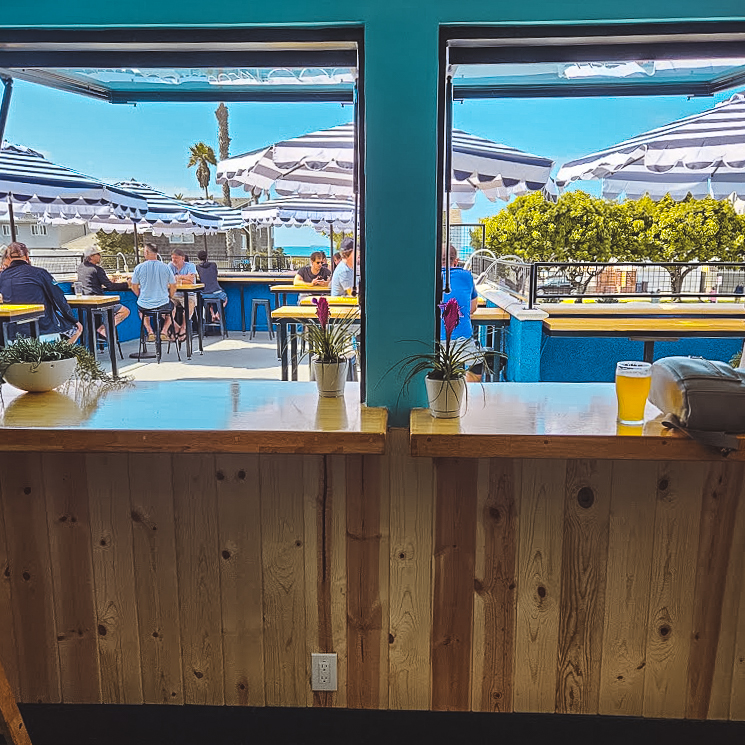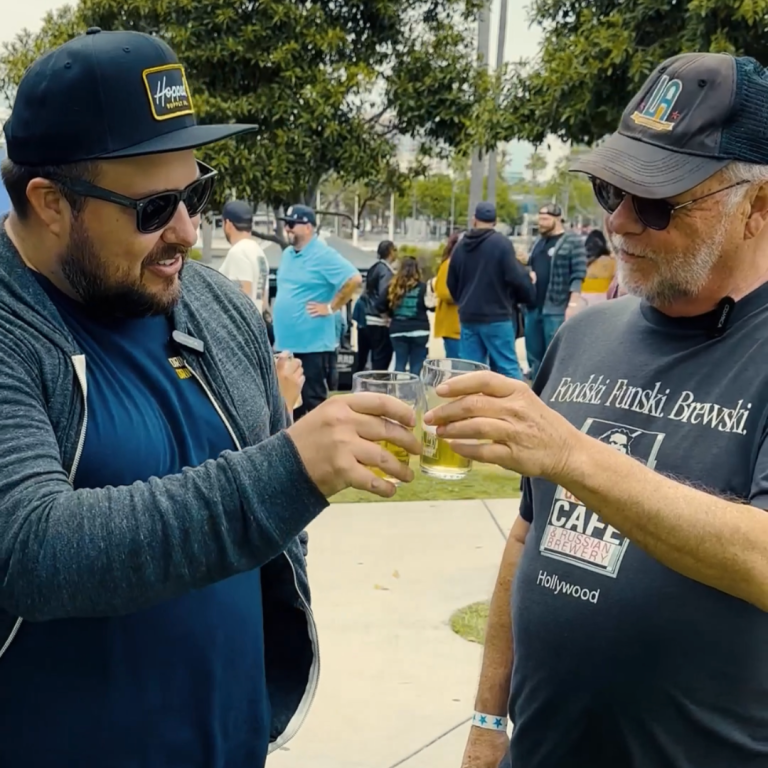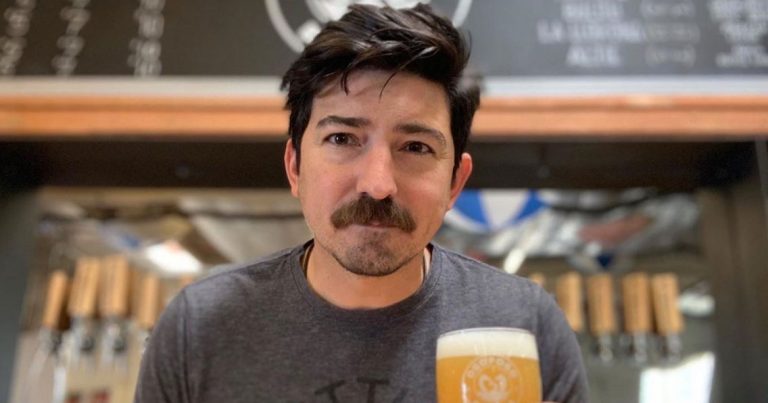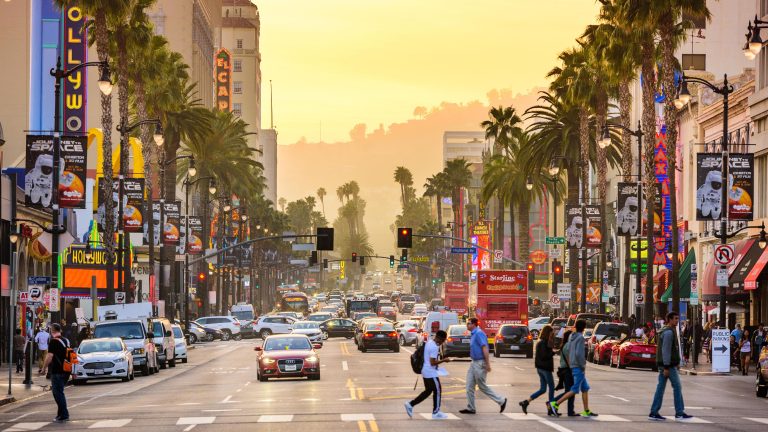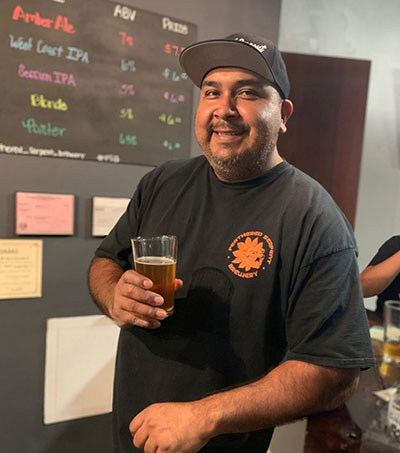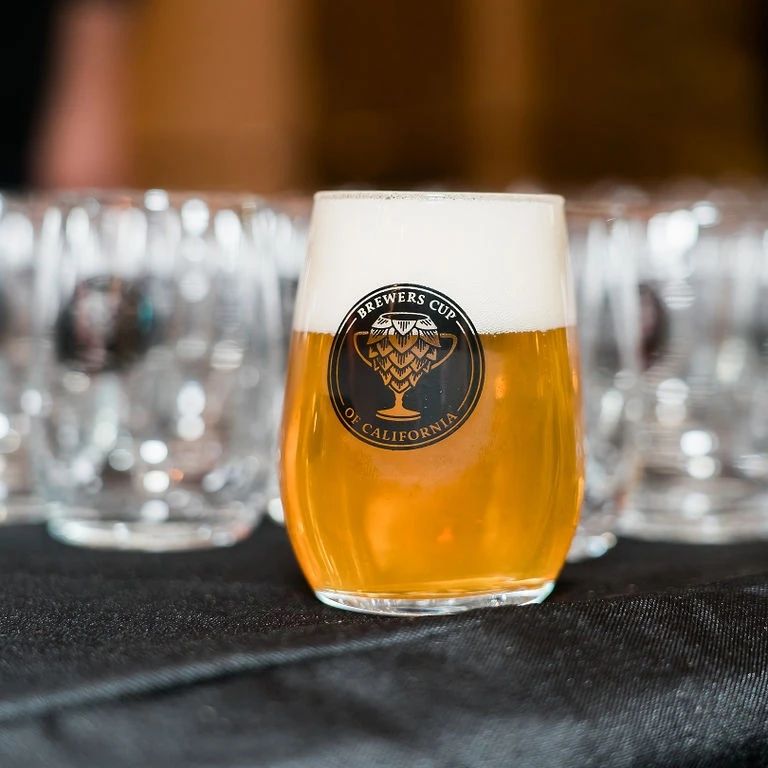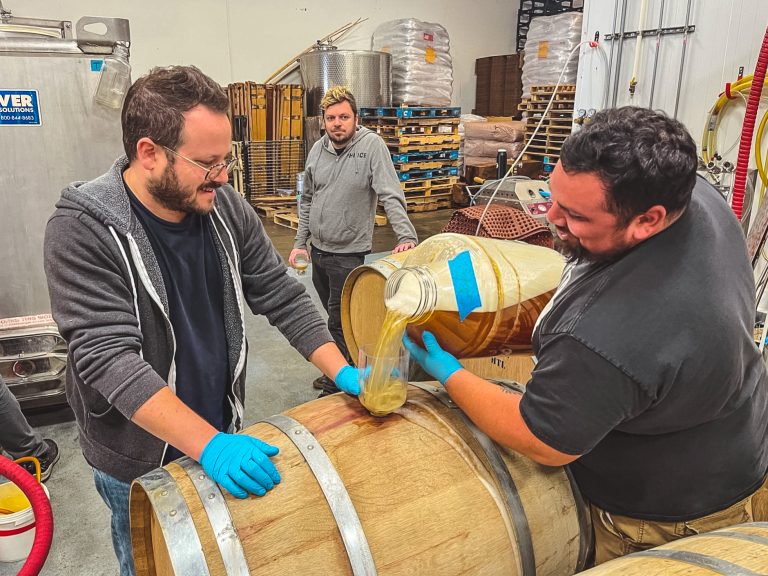As far as a local beer scene is concerned, it took a while for Los Angeles to catch up, but these days, the Southland has so many breweries that it would be impossible to visit all of them in one weekend. The Los Angeles County Brewers Guild lists 92 breweries within the county limits. But, how many of those are synonymous with Los Angeles itself? Just a few, and at the top of that short list is Highland Park Brewery.
Bob Kunz started HPB in a tiny kitchen space at the Hermosillo, in the neighborhood that gave his brewing project its name. He has since expanded to a spacious, 15-barrel Chinatown taproom that boasts a loyal customer base eagerly drinking his always on-par IPAs and hoppy pilsners. When there’s a Dodger game going on next door in Chavez Ravine? Good luck trying to find a table.
From a regularly rotating tap list to their Dodgers-inspired merch, HPB has hit home run after home run, making it the go-to space for locals. We wanted to find out how Kunz pulled this off, especially since he’s a Montana kid who started his beer career up in Washington State. Kunz and his wife moved to Los Angeles in 2006 and officially opened HPB’s doors in 2014, and he’s definitely one of us now, as you’ll see in this latest installment of The Session.
Emily Krauser: How did you get into brewing?
Bob Kunz: I am a tactile person. If I tasted or had an interest in something, I wanted to see how it was made in a very hands-on way. I’m 39 right now, and pretty much right when I turned 21 I started drinking craft beer. I was into good food and beverages, and beer is one of the more approachable, price-wise, in that world, where you can drink the best pale ale in the world and it’s still less than $10 a six-pack or whatnot. The value side of it drew me in. This was during college, and I just dove right in and immediately started homebrewing. I started out with a sort of extract brewing on the stove for a year or two, and then I got an internship at Boundary Bay Brewing up in Bellingham, Washington. The guys at that brewery really guided me to go all-grain, which at that point in time was this huge unsurmountable step, and it was a big leap. Those first couple of years were pretty rough.
Those first couple of years, it was me and Josh Pfriem of pFriem Family Brewers up in Hood River, Oregon. He has been one of my best friends for most of my life, and he’s the founder of that brewery. Josh and I were roommates at the time at Western Washington University. We started homebrewing together, but we really didn’t have anybody guiding us at all, so we probably had 10 to 20 batches of pretty terrible, infected beer, which is probably most people’s story. It’s pretty interesting when you don’t have other people that have done it longer than you and you’re kind of guiding yourself. So, the real big step was when I got that summer internship, cleaning kegs and exteriors of tanks and walls and stuff like that. Those guys gave me some basic principles, and that’s where it really launched, where I started making a little bit higher quality beer and really fueling my passion.
What it was like to go from the back of Hermosillo to opening a massive taproom in Chinatown in 2018?
We started the process of opening the brewery in 2013, but really, the process of opening a brewery started back in 2001 when I did my first homebrew batch and it was like, This is what I’m going to do. This is it. I’ve kind of worked my whole adult life towards this dream of opening a brewery, and it’s hard to get the funds and the experience, so I felt very fortunate to be able to open up the brewery at the Hermosillo on a bootstrapped micro-budget. They say necessity is the mother of all inventions, and it definitely is the case with us. We had like $130,000 and used every penny of it to get open, with me doing most of the build-out, but it was a really great experience because it forced me to become more intimate with the product and the facility and the process. Even though we didn’t have — and still don’t have — the best equipment or the biggest space, it really allowed me to hone in on my senses and ability to problem solve and troubleshoot and be a critical thinker in both the process of making beer and running and operating a facility. Facility management is almost more difficult than the actual production of the beer because you need all of this manufacturing equipment and to know how to run and operate glycol chillers and burners and tanks and so on.
I digress, but my point is that the experience was amazing. It was incredibly hard because it was running a business and brewing all the beer and doing pretty much everything else. Wearing too many hats definitely stretches you thin and it wasn’t sustainable. The Hermosillo was such a great experience, but we’re selling our beer to them at wholesale costs, so we’re like the world’s smallest little production brewery operating on the thinness of margins. That first year, I think I was bartending three nights a week to just pay my bills! We saw right out the gate that we needed to grow. It’s a process to find a location and fund a project, but fast forward from that point in about 2015 to finding [our Chinatown] location in 2016, then we went through the whole process of signing the lease and finding architects and general contractors. It was a very big step to go from being intimately involved in all facets and self-sufficient to this bigger project where it’s more important that you’re developing and growing a good team and leading them rather than developing and honing your own individual skills. It’s been immensely challenging but immensely rewarding going from two people at the Hermosillo facility to 31 people at the Chinatown facility.
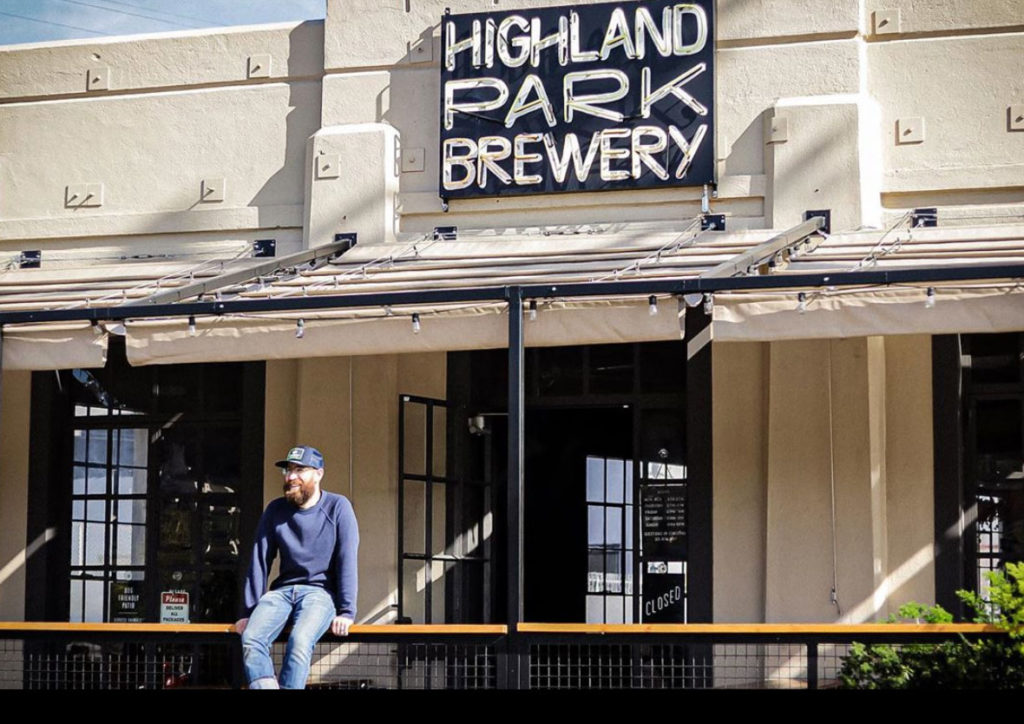
That first year in Chinatown was the hardest thing I’ve ever done. It strained all of the relationships in my life, it strained our finances — just all these things that it’s hard to see the reward of at that point because you’re so thick in the weeds. It wasn’t until building this leadership team in 2019 that it started to come together and I really started to see the reward of that growth phase. We’re gotten through all of those really, really difficult growing pains and moved into this point of growth as a management team, and it’s awesome to see them develop. We’ve built a team with collective knowledge and experiences that allow for the level of quality, community and culture for our staff that I had envisioned. The brewery as a whole is starting to come into its own and it was a better, more fun experience at our taproom, prior to this coronavirus situation.
My goal has always been to sell beer direct to consumer. That’s why we don’t distribute a lot of beer and we don’t put our cans on the shelves of grocery stores, because I feel like the relationships are so much more rewarding and richer when you’re dealing directly with your customers. The freshness of the beer is better, the margins are better for the business, and the consumers get to interact directly with the producer. It’s all these win-win things, and that Chinatown facility has really allowed my whole vision of what I wanted the brewery to be to come to fruition. So, it’s been fucking amazing moving into this era of the Chinatown facility and realizing these things fully.
When I think of L.A. proper — as in the city limits — and our beer here, Highland Park is the one that to me is synonymous with the city, and I think a big part of that is the community you mentioned. It’s my go-to to do work at, and I’ve been there before Dodgers games and seen everyone in blue and white, plus you’ve got shirts that pay homage to the Dodgers. Was that a goal to be so entrenched and associated with L.A.?
It’s been interesting. Things evolve and adapt based on what you’re surrounded by and influenced by. The first couple of years my wife and I lived here, it was like, how do we get out of here? We didn’t fully get it. Each year since then, it gets more and more in our blood, and I love it now. The initial pursuit of opening the brewery was just this pursuit of excellence in beer, but it’s fascinating having a company and you start to have employees and you start to have customers, and then all of a sudden, your brain starts to shift. I can’t help myself but pursue that excellence in beer. That’s an involuntary reaction within me — I’ve been doing it so long. It’s my life pursuit, but it’s cool to see this shift where the community and culture of what we’re doing is being integrated into the fabric of Los Angeles. It’s really awesome and meaningful to me to have that. And I love hearing that, where people are like, ‘It’s my go-to for whatever.’ Even with the Dodgers, I’ve loved baseball since I was a kid, but as I became an adult, I kind of slowed down in paying attention to sports, but we have a lot of team members that are very into the Dodgers. It has been this really natural progression, where we went into Chinatown and knew we were close to the stadium and may get some business, but our staff is having fun and walking up to the games and the Dodgers audience is coming in. It’s almost a cultural thing beyond baseball, just this game day festivity, and it’s mixing so many different demographics. It’s so cool to see this natural connection from a wide spectrum of income levels and races and ages. A goal of ours was to create a space that felt comfortable and welcoming and fun, and you go in there, and there’s this massive diversity of people. I love that that is the result of trying to just be an open human being and welcome people.
What’s the biggest difference that you’ve seen from starting off in Washington to now being a part of the California beer scene?
Well, I haven’t lived there in a while, so I guess take this with a grain of salt, but the thing that was so striking to me initially is that — and I don’t know if this is going to come off as bad or not — in Washington in 2001, when I turned 21, until I moved out around 2005, craft beer was everywhere. It was so saturated in a wonderful way. You go to a dive bar or a hotel to a chain restaurant, and the majority of the taps were craft beer — it was just an expectation. Then coming to California, it was this interesting juxtaposition where there wasn’t as much, but what was immediately glaring to me was that the quality was way higher. That first year or two living in L.A., we’d go down to Pizza Port like every other weekend just to experience those hoppy beers — that golden age around 2007 and 2008. It was really this light bulb moment of what quality and freshness combined could be. I think in the Northwest, you get a lot of fresh beer — beer that was just made on-premise at this place — but then the execution wasn’t always the best and the packaged beer off the shelf wasn’t always the freshest, but I feel like those things came together when I moved to California. We were drinking beer at these brewpubs down in North San Diego County where it was really something fantastic. I don’t mean to shit on Washington because there’s tons of great beer up there, but I feel like it stepped up a notch when I came to California. I mean, it’s a different world now. That was a point where people were hungry for local craft beer but there was less discernment, and in the past 10 years, that’s shifted. Globally, consumers are not willing to put up with beer that was made locally but isn’t really high-quality, and I think the quality has definitely risen quite a bit in the Northwest [in recent years].
What HPB beers are you drinking right now?
Well, I haven’t been bringing them home, but I am loving Thunderbolt Gold, our helles. I typically bring cans home and that is only available in crowlers right now, so I haven’t been drinking it as much. I love, love, love lager beer, so Fill Pils is my jam right now — it’s a German-style lager — and our Baseball lager.
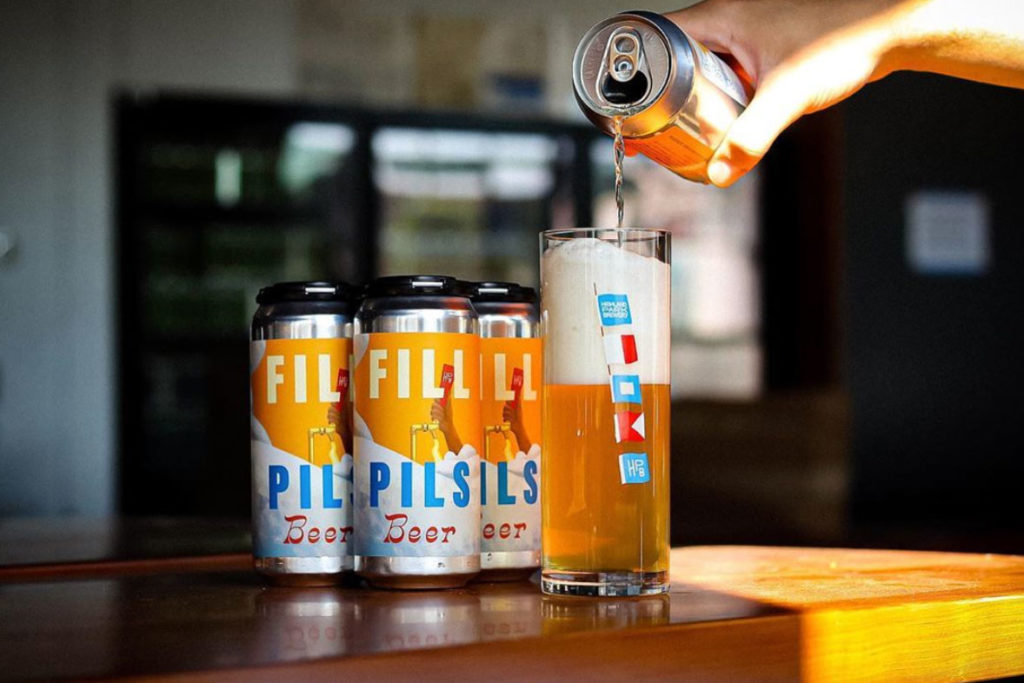
I know lagers are the beers brewers love to both make and drink. What would you suggest for someone who doesn’t typically reach for one — you know, like me, for example…
If you haven’t had the Crosbo Pils, it’s available in cans right now, and that used Idaho 7 and Strata, so it’s kind of in the Timbo Pils vein. It’s sort of that nice marriage of IPA and lager, and it’s very, very hop forward.
For more from Kunz and how he and HPB have been doing amid the pandemic, check out our previous story regarding L.A. breweries and that very subject here.
